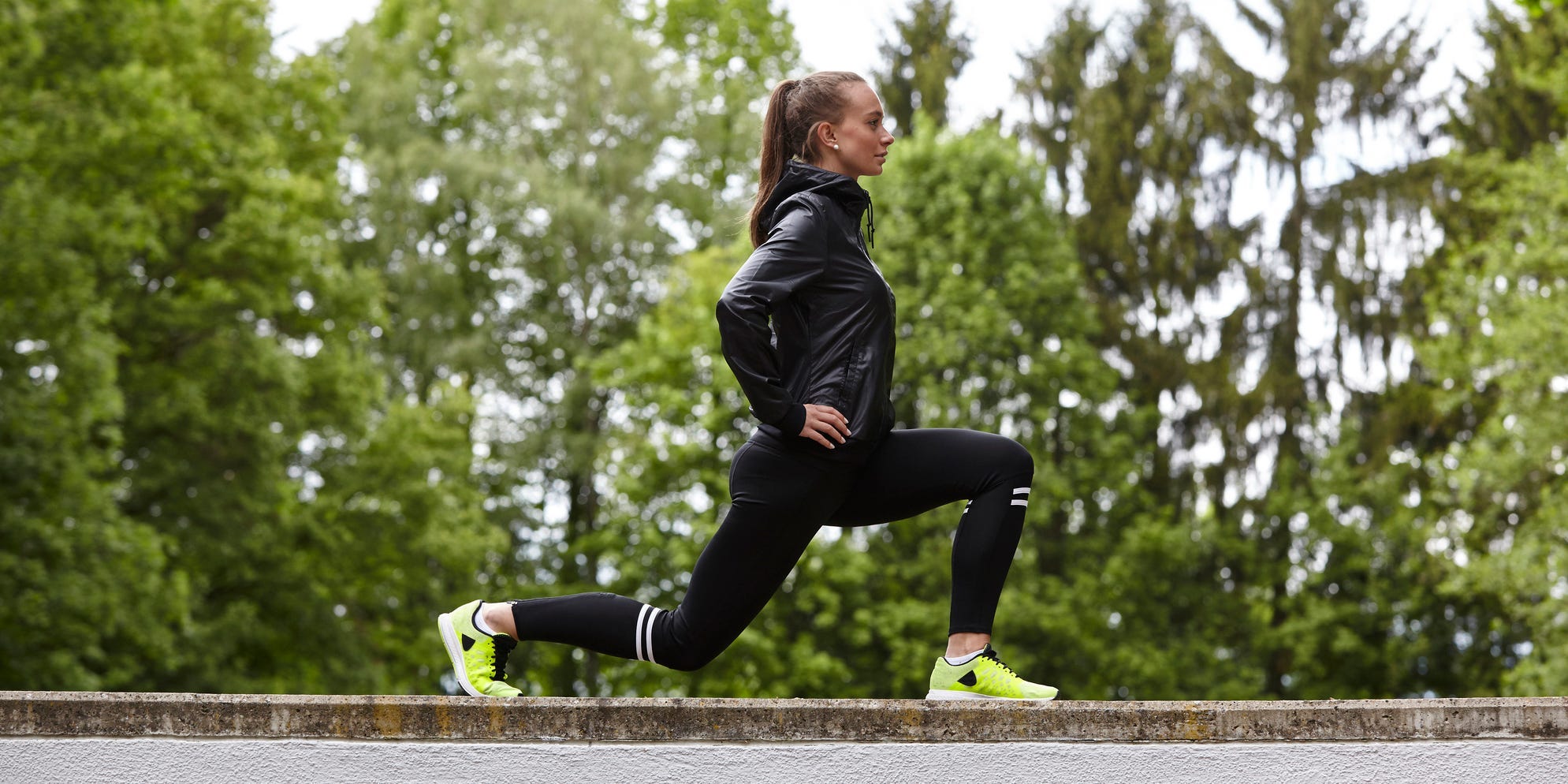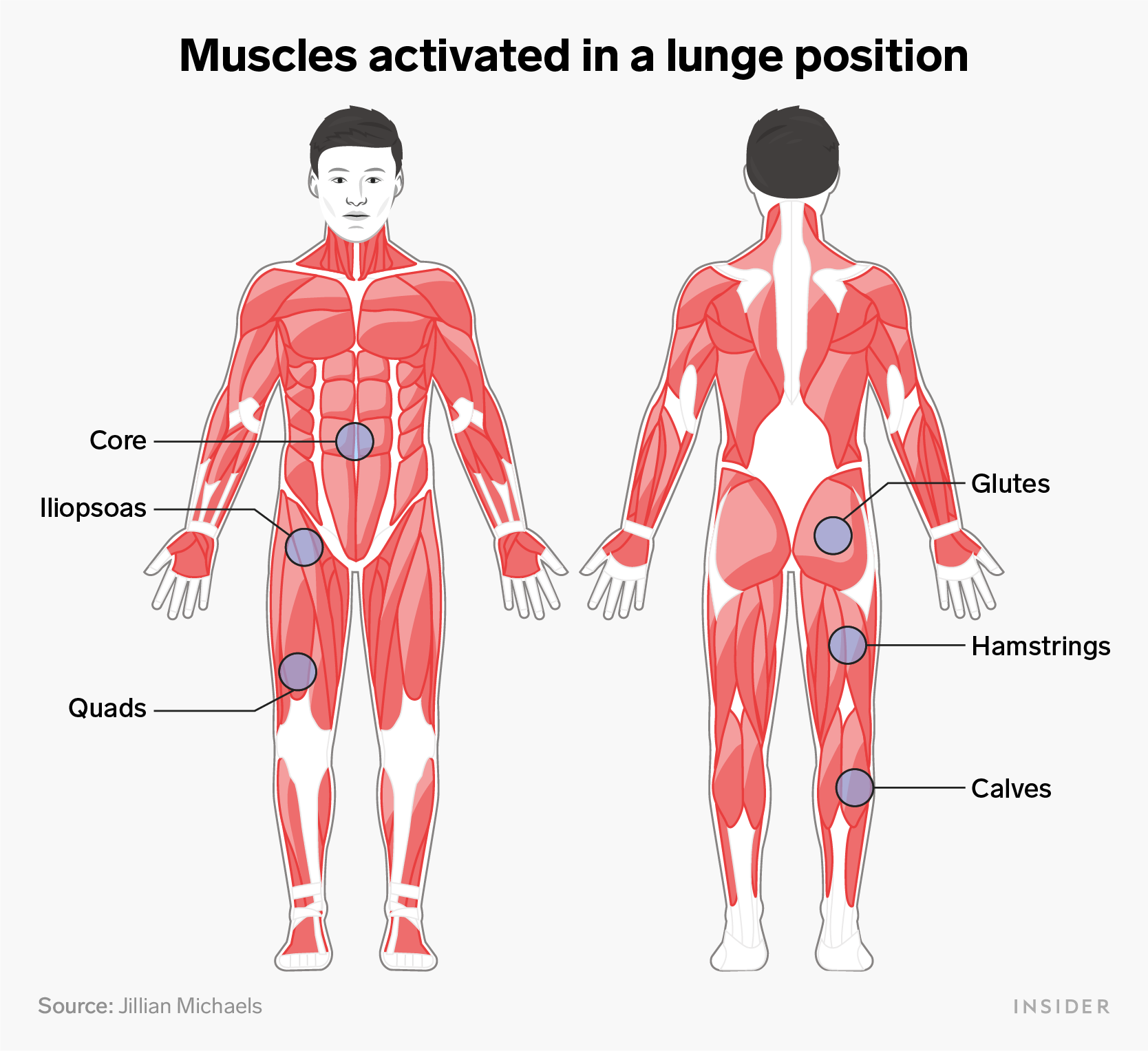
Maria Fuchs/Getty Images
- The benefits of lunges include a stronger lower body and core, as well as improved balance and flexibility.
- In addition to basic forward lunges, there are many lunge modifications that can target specific leg or core muscles, such as curtsy lunges, reverse lunges, side lunges, and twist lunges.
- To achieve the health benefits and reduce your risk for injury, it’s important to do all your lunges with proper form.
- This article was medically reviewed by Joey Thurman, CSCS, CPT, FNS, a Chicago-based fitness expert and MYX Fitness coach.
- Visit Insider’s Health Reference library for more advice.
A lunge is an excellent body-weight training exercise that can help you with your overall health and athletic performance. Specifically, lunges are a popular exercise because they can improve strength, flexibility, and balance.
Here’s what you need to know to achieve the health benefits of lunges and do them with proper form.
Lunges strengthen major muscle groups
“Lunges work multiple larger muscle groups at the same time,” says celebrity trainer Jillian Michaels, creator of The Jillian Michaels Fitness App. “They build lower body strength and help to maintain muscle mass and bone density in the lower body.”
Lunges target the following muscle groups:

In particular, a small study published in 2006 in ACE Fitness found that the forward lunge is one of the most effective exercises for working the hamstrings, gluteus maximus, and gluteus medius. The study found that the forward lunge activated these specific muscles more than body-weight squats, leg presses, and hip extensions.
Lunges can improve balance and flexibility
Lunges are lower body unilateral exercises, which means that they work one leg at a time. The American Council on Exercise says that these exercises are especially helpful at the following:
- Improving balance
- Aiding in injury prevention
- Correcting muscle imbalances
- Helping with rehabilitation
Since you're working one side of the body, it causes you to become unbalanced, forcing your body to counteract this to avoid falling. By doing so, you're working the muscles that help keep you balanced.
"Lunges can prevent injury throughout your daily life and your workouts," Michaels says. For example, according to Harvard Health, doing lunges, squats, and planks can help prevent back pain, back injuries, and improve posture.
How to do a lunge properly
Proper form is always important when exercising in order to work the correct muscles and avoid injury. According to Michaels, here's how to do a proper lunge:
- Stand with your feet hip-width apart and hands on your hips.
- Squeeze your glutes and ensure the front of your hips are facing forward, not to either side.
- Then, take a step forward with your right or left leg, ensuring that your feet are still hip-width apart.
- Keeping your spine totally straight and perpendicular to the floor, slowly lower your body down toward the ground. Bring both legs into a 90-degree angle with the front knee over the front ankle and the back knee directly under the hip. "Create a straight line from your ear to your shoulder to your hip bone to your back knee," Michaels says.
- Then press back through the front foot to return to the starting position, and repeat on the opposite leg.
In addition, you should avoid these common mistakes:
- Don't slouch or curve your back; maintain good posture
- Make sure your knee is bent properly and you are under control throughout the entire lunge
The American Council on Exercise advises that you should do three to four sets of 15 to 20 lunges per leg. Beginners can start with two to three sets of 10 to 12 lunges per leg.
You can watch the following video to see how to do a basic lunge correctly. This tutorial is courtesy of Stephen Navaretta, a fitness trainer specializing in functional movements and calisthenics.
You can also try these lunge modifications for a challenge:
Curtsy lunges
Curtsy lunges especially target your thigh and glute muscles. Instead of stepping forward, you will step back to your opposite leg, crossing your leg over and bending your knee in one fluid motion.
Reverse lunges
Reverse lunges are the exact opposite of forward lunges. You step back instead of forward. Reverse lunges mainly target your glutes.
Side lunges
Side lunges, or lateral lunges, work the legs' major muscle groups, including the inner and outer thighs. Instead of stepping forward, you step to the side.
Twist lunges
Twist lunges focus on your core more than the other lunges. Instead of putting your hands on your hips, hold them out in front of you so that they are parallel to the ground. When you bend your knees to lunge, pause and twist your arms to your side, pointing to the left if the right leg is forward, and vice versa.
Takeaways
The benefits of lunges include increasing your flexibility, stability, and strength. They can also reduce your chances of injury throughout your day and while exercising.
Proper form while doing lunges is essential. If you want leaner legs, a toned booty, and stronger quads, glutes, hamstrings, calves, you should include lunges in your regular workout routine.
Related articles from Health Reference:
- The health benefits of push-ups and how to do them correctly to get the most out of your workout
- 5 health benefits of jumping rope and helpful tips for beginners from celebrity trainer Jillian Michaels
- How to do suspension training exercises at home to get a full-body workout
- 3 major health benefits of jumping jacks and how to do them properly
- 9 tips to run properly, and why your running form matters
